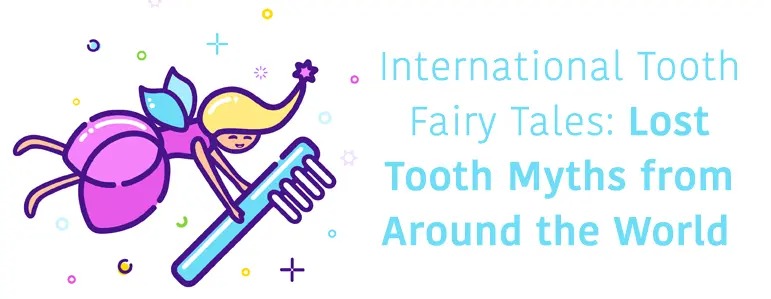
Losing a tooth is a universal rite of passage every kid on the planet goes through. Shedding those first teeny baby teeth, in favor of something bigger and more permanent, is one of the first signs your little one is growing up. And with loose teeth come that first inevitable visit from the tooth fairy herself. As a parent, it can be tough to figure out how to tackle the myths that come along with childhood.
How much money does the tooth fairy leave? How long do you tell kids the story is true? What are some tooth fairy tales you can share with them?
The tooth fairy is one of the more unusual myths we tell our little ones. Save for maybe the Easter bunny, the tooth fairy is a strange and often confusing little imp. What does she need those teeth for? Why do kids get different amounts of money? And the list goes on and on …
We’re all familiar with the current iteration of the myth. A kid’s tooth falls out, they slip it under their pillow, and the tooth fairy brings them a reward in exchange for their offering as they sleep.
Most cultures have some form of a ritual to mark the new beginnings a new set of teeth signifies. From Asia to South America, from Iraq to Jordan and Jamaica, these rituals show we’ve all got a lot in common, though other countries incorporate birds, mice and more into the toothy tradition. Here’s a look at some of the tooth fairy stories from around the world.
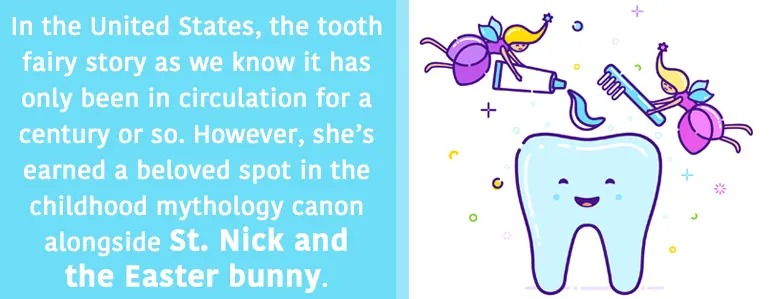
Because our planet is home to such a diverse array of tooth-losing traditions, the basis of her origin story has some history behind it. The tooth fairy draws on inspiration from a few different traditions. As much as we Americans would like to lay claim to this popular legend, the tooth fairy myth is used in a number of English-speaking countries, from Australia, England, New Zealand and Canada, as well as Finland and Denmark. The Danish basically use the same tradition, only the tooth fairy is known as “Tandfeen” and leaves money behind.
Here’s a quick rundown of how the modern tooth fairy became a major part of many a childhood.
The whole concept of humans and their relationships to fairies, particularly in a monetary exchange, have long been part of English and European folklore, which extended to the Americas and beyond when colonization started.
European children used to bury their baby teeth in the garden near their homes, in hopes of “growing” a new tooth in its place — a tradition that some countries have held onto to this day. Still, as cities began to grow, the tooth burial ritual dropped in popularity, with potted plants taking the place of a more expansive garden, which then led to children burying the tooth under their pillows instead.
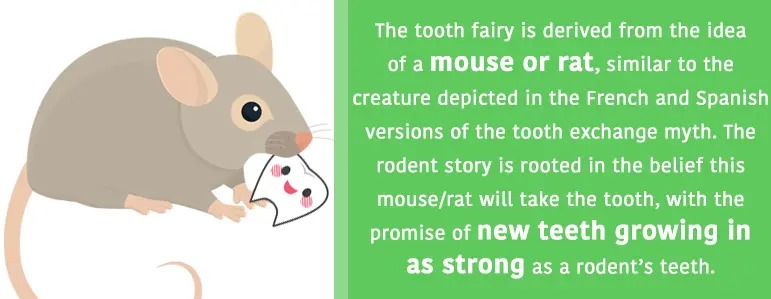
The concept of teeth growing in strong and sturdy, like a rat’s, or another strong-toothed creature such as rabbits or squirrels, demonstrates a kind of transference — something anthropologists refer to as sympathetic magic.
This is called the Raton Perez story in Spanish-speaking countries. It has evolved into the mythical rodent leaving money or small gifts in exchange for the child’s tooth.
Americans adopted the fairy, a traditional European character, around the same time Disney films were gaining some traction. Movies such as Cinderella feature kindly fairies who bring wish fulfillment, though it deviates a bit from the idea of growing strong, rat-like chompers.
Aside from the Raton Perez and Disney parallels, the tooth fairy may be traced back to some older European folklore as well. The teeth-burying tradition was shrouded in superstition, and some believed if a witch found the tooth, they could place a curse on the child and the tooth-holder could gain power over the child. Getting rid of the tooth helped alleviate some of those fears, turning an old superstition into a fun, whimsical tradition.
As far as money is concerned, the tradition of leaving it under pillows started in the U.S. and may have started as a symbol of shedding a part of your childhood in favor of becoming an adult with each tooth lost. While some cultures and families offer gifts in place of a lost tooth, cash is often used, as it represents a stepping stone of sorts into adulthood, signifying increasing agency and responsibility.
Now let’s take a look at how the tooth fairy myth evolved in other parts of the world.
In Spanish-speaking countries such as Spain, Mexico, Peru, Chile, Argentina, and Colombia children partake in a similar myth to the tooth fairy, Ratocinto Perez, who also goes by El Raton de Los Dientes, Raton Perez and Perez Mouse. Whatever name he goes by, Perez operates much in the same way as the American tooth fairy, collecting baby teeth from children while they sleep.
Much like the tooth fairy, Perez only takes teeth after they have fallen out and are placed beneath the child’s pillow as they sleep. The mouse takes the tooth and leaves behind a gift, sometimes money and sometimes another small prize, for the child to find in the morning.
In Argentina, kids opt to stick their recently separated tooth in a glass of water before heading to bed. When Perez arrives on the scene, the thirsty mouse drinks the water and takes the tooth, leaving a small gift or money in the glass.
The origin of this story dates back to the 1890s, with child prince Alfonso XIII. Alfonso was born after his father, the king, died, and his mother, Queen Maria Christina, was to rule until Alfonso turned 16 and was eligible to assume the crown. When Alfonso began losing his teeth, he was afraid, and his mother turned toward Father Luis Coloma, a popular writer at that time.
Coloma created the tale of the Raton Perez, a small mouse who visited a sickly prince, carrying a red satchel for collecting lost teeth and leaving a small amount of money in their place. The young prince caught Perez one night, and the mouse took him around to visit other children as they sleep. The tale had a moral bent to it, as the mouse showed the prince how the other half lives, taking him to a mouse home in a repurposed biscuit box, adding in a moral about helping the poor into the end of the tale.
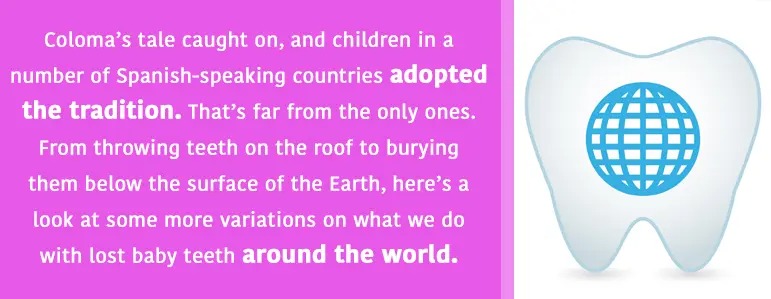
France
In France, as well as Belgium, Morocco and Switzerland, children leave their teeth under the pillow for La Petite Souris, or the Little Mouse, who takes teeth and leaves a coin or a bill behind to replace the tooth.
No one is quite sure where the myth originated, though it is thought to come from a 17th century tale known as “The Good Little Mouse.” Strangely, this is a completely different tale of a mouse. In this version of the story, a fairy is turned into a mouse in order to help a queen defeat an evil king. The teeth come into play when the mouse hides under the king’s pillow at night, stealing all of his teeth as he sleeps.
Italy
Perhaps it’s because of proximity to a variety of tooth-losing traditions or just an appreciation of different mythologies, but many Italian children get a hybrid version of tradition, often believing in two major icons, a tooth fairy and a benevolent mouse.
South Africa
Children in South Africa place their lost teeth inside of a slipper rather than safely beneath their pillow, in hopes that a mouse will come take the teeth and replace them with money or a gift.
El Salvador
Instead of playing to a fairy or a mouse, children in El Salvador place teeth under their pillow and wait for a rabbit, another creature with an aspirational set of teeth, to come and collect the lost tooth.
Alaska
Certain native tribes in Alaska feed baby teeth to an animal, such as a dog, asking the creature to bring them a new tooth in place of the old one.
Brazil
In Brazil, children toss the lost tooth outside in the hopes a bird will come to pick it up. The bird will not accept dirty teeth and will not leave a gift if a tooth looks dirty, emphasizing good brushing habits for little ones. If the tooth is clean, the bird leaves behind a small prize or money in place of a satisfactory tooth.
Japan
In Japan, teeth are thrown, but they where they go depends on the type of tooth. Bottom teeth are thrown to the roof, while the upper teeth go into the ground, mimicking the trajectory that ideal tooth growth takes, straight and strong.
Turkey
In Turkey, children are taught their baby teeth hold some weight as to how their future will turn out. For example, if the tooth is buried near a doctor’s office, the child may grow up to be a doctor. If the tooth is buried in a field the child may grow up to be a baseball player or a soccer star. Luckily, children lose a lot of teeth, so they can change their mind a few times.
Ukraine
In the Ukraine, children seek out the darkest corner in their house, wrap a tooth in a tissue or cloth, and leave it in the dark. The child whispers something along the lines of, “Take my old tooth and bring me a new one,” leaving the tooth in the same place until the new one grows in.
Greece
In Greece, children toss their teeth onto a rooftop, making a wish that the new tooth will grow in strong and healthy.
Dominican Republic
In the Dominican Republic, kids also partake in throwing their teeth on the roof, but this time in the hopes a mouse will bring them new teeth in their place.
Nigeria
In Nigeria, children play a game when they lose a tooth. Boys find eight stones and clasp them tightly in their fist, along with the tooth in question. Girls do the same but with six stones instead of eight. The kids close their eyes, count to a number equal to the stones in their hand, and say, “I want my tooth back!” The children toss their fist into the air, running away as fast as possible.
Lithuania
In Lithuania, many kids hang onto their teeth rather than trading them in for cash or a gift. Many children keep them in a special box, while others may make them into a necklace or other keepsake. However, some kids do also believe in a version of the tooth mouse. In that tradition, they toss their lost teeth behind a stove, in the hope of getting a new tooth as strong as iron.
Middle East
Kids in Egypt, Jordan, Iraq and more throw their teeth up in the air toward the sun, asking the sun to send them better adult teeth in return for their gift.
Korea
In Korea, children also throw their baby teeth to the roof, in hopes a blackbird will bring them a new tooth, and sing a song to commemorate the occasion that goes something like this: “My old tooth I give to you, bring me a new tooth.”
Pakistan
In Pakistan, children wrap their lost teeth in a cloth and throw them in the river, as it’s considered good luck.
All kids are different, but most start losing their teeth around age 6, or around the time they start kindergarten or first grade. The bottom teeth usually fall out first, then the top, and finally those heavy-duty back molars. While we may forget what it was like to be that age and have our original teeth, your child may have some fears about losing their baby teeth. Here are a few tips to get them ready for one of their first big physical changes.
Don’t let your kid be blindsided when a tooth becomes loose or falls out. Granted, they’ll likely hear about this stuff from their peers or from a teacher, but giving them a heads up and letting them know losing teeth is an experience everyone goes through as they get older might alleviate some woes.
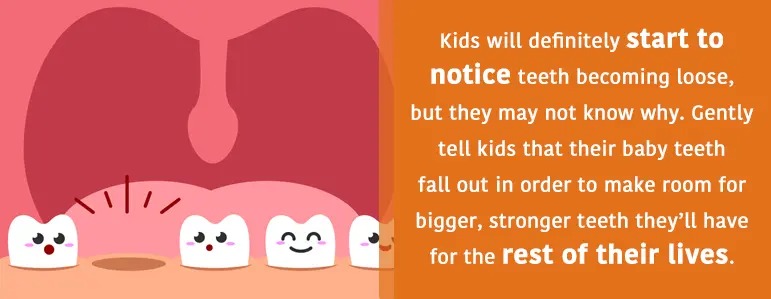
Wait patiently until the tooth is ready to come out. It should feel extremely loose. Use gauze or a clean tissue to firmly grasp the tooth and quickly pull it out. The first teeth may require a parent’s help, but as kids get older, they may want to take this on themselves.
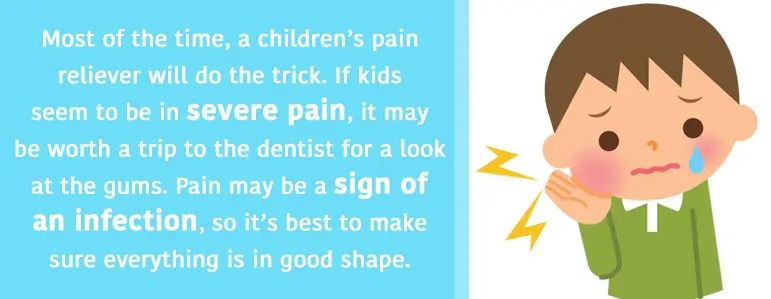
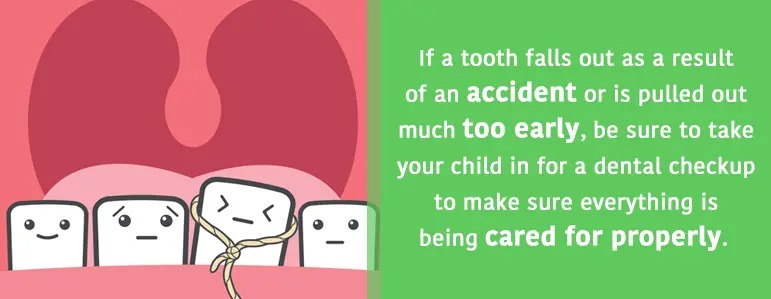
Again, while baby teeth are by no means permanent, a healthy mouth helps set the tone for healthy adult teeth.
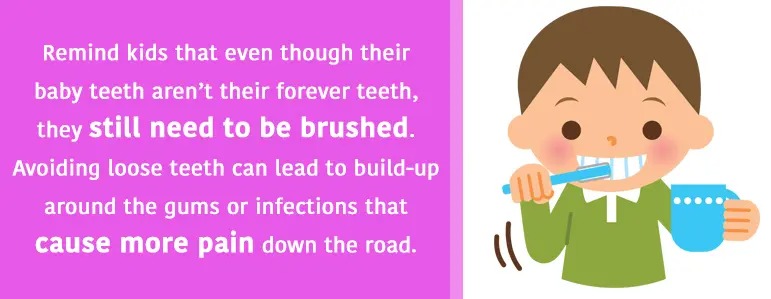
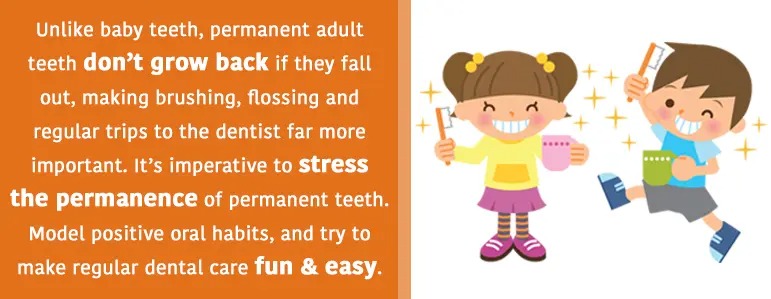
The tooth fairy, Raton Perez, or any other mythical characters are important to young children as they begin to shed these literal symbols of childhood. Be sensitive to the anxieties that may arise, but embrace the excitement that goes along with it. Kids generally look forward to the day they lose their first tooth, proudly showing off a new gap to friends, siblings, and teachers, and they are often impatient when that first one comes loose.
Ultimately, you’ll want to foster a sense of positivity surrounding this rite of passage, whether you fully embrace the tooth fairy myth or opt for a more realistic approach to teaching your child about oral hygiene. Perhaps you’ll introduce your child to another tradition or make your own — either way, it’s up to you!

Whether you’re looking for a cleaning or something a little more involved, we’re glad to take care of the first round of teeth, ensuring healthy habits straight out of the gates and maintaining permanent adult teeth for the long haul.
We know it can be hard to find the right dentist. With so many options, it can be hard to find one that meets your family’s unique needs. If you’re in the Glendale, Peoria or Chandler area, give us a call at 623-777-2037 to make an appointment or learn more about the dental services we provide.